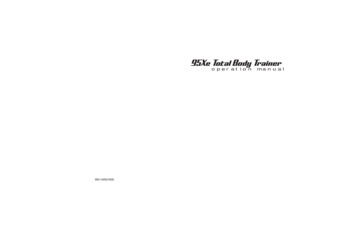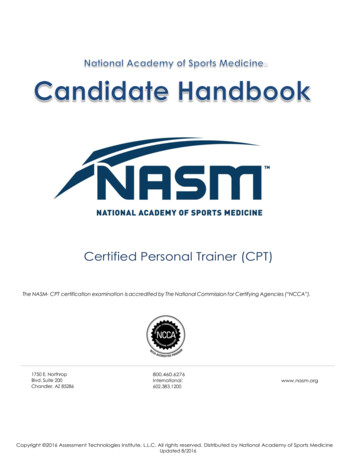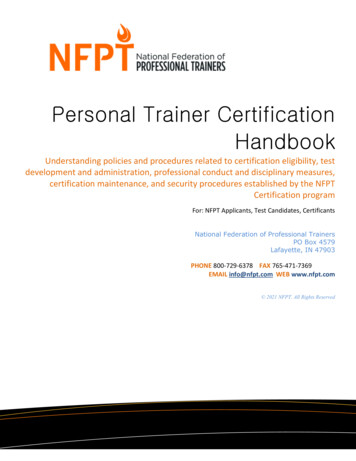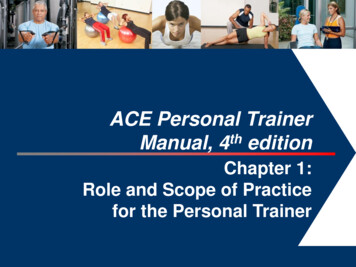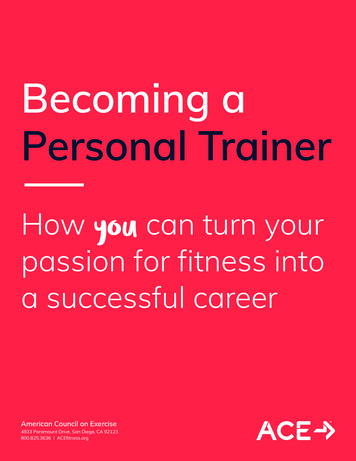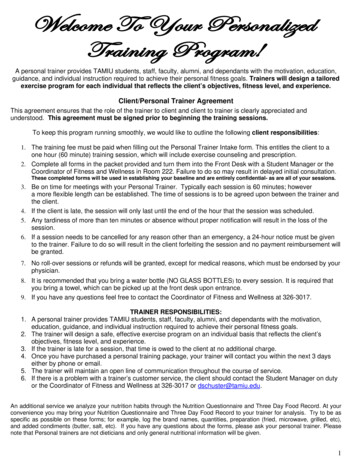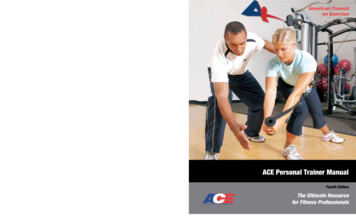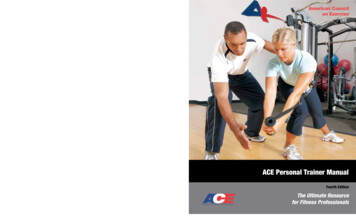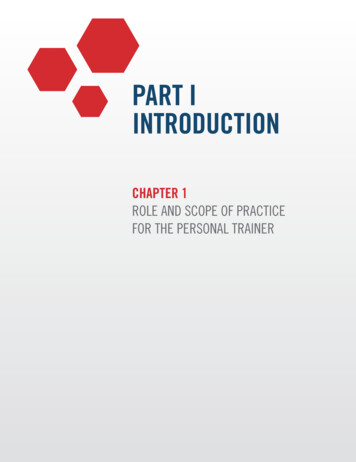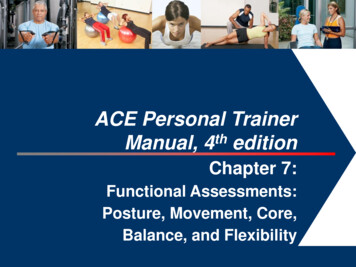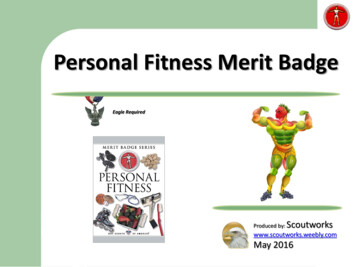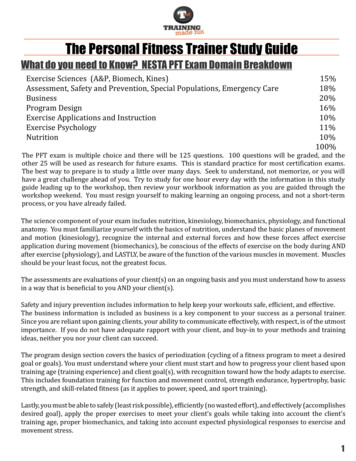
Transcription
The Personal Fitness Trainer Study GuideWhat do you need to Know? NESTA PFT Exam Domain BreakdownThe PFT exam is multiple choice and there will be 125 questions. 100 questions will be graded, and theother 25 will be used as research for future exams. This is standard practice for most certification exams.The best way to prepare is to study a little over many days. Seek to understand, not memorize, or you willhave a great challenge ahead of you. Try to study for one hour every day with the information in this studyguide leading up to the workshop, then review your workbook information as you are guided through theworkshop weekend. You must resign yourself to making learning an ongoing process, and not a short-termprocess, or you have already failed.The science component of your exam includes nutrition, kinesiology, biomechanics, physiology, and functionalanatomy. You must familiarize yourself with the basics of nutrition, understand the basic planes of movementand motion (kinesiology), recognize the internal and external forces and how these forces affect exerciseapplication during movement (biomechanics), be conscious of the effects of exercise on the body during ANDafter exercise (physiology), and LASTLY, be aware of the function of the various muscles in movement. Musclesshould be your least focus, not the greatest focus.The assessments are evaluations of your client(s) on an ongoing basis and you must understand how to assessin a way that is beneficial to you AND your client(s).Safety and injury prevention includes information to help keep your workouts safe, efficient, and effective.The business information is included as business is a key component to your success as a personal trainer.Since you are reliant upon gaining clients, your ability to communicate effectively, with respect, is of the utmostimportance. If you do not have adequate rapport with your client, and buy-in to your methods and trainingideas, neither you nor your client can succeed.The program design section covers the basics of periodization (cycling of a fitness program to meet a desiredgoal or goals). You must understand where your client must start and how to progress your client based upontraining age (training experience) and client goal(s), with recognition toward how the body adapts to exercise.This includes foundation training for function and movement control, strength endurance, hypertrophy, basicstrength, and skill-related fitness (as it applies to power, speed, and sport training).Lastly, you must be able to safely (least risk possible), efficiently (no wasted effort), and effectively (accomplishesdesired goal), apply the proper exercises to meet your client’s goals while taking into account the client’straining age, proper biomechanics, and taking into account expected physiological responses to exercise andmovement stress.1
As you progress, keep an open mind. It is just about at the moment you think you have things figured out,that you will realize you have a long way to go. It should be this way for everyone. There is a reason why noone has all the answers. No one has all the answers because there is always something to learn and there istoo much to know. Be easy on yourself and do not expect to know everything. And do not be so ignorant orarrogant to believe that you know more than other trainers. Simply seek to do what is best for your client(s)by constantly improving your knowledge, skills, and abilities.Your journey either starts, or simply continues here.2
Obtaining and Retaining ClientsTraits of a Professional, Certified Personal Fitness TrainerA professional personal trainer must be a strong communicator, confident, professional, action-oriented,energetic/enthusiastic, and must employ the “Platinum Rule”.To be professional means to be consciously aware of not only your client’s needs, but of the needs of other clubmembers, your manager, your fellow employees, and anyone else who might be affected by your performanceand actions while you are training or at your place of work. It is not enough to singularly focus on yourclient while training, you must constantly be aware of the training environment around you and not infringeupon the efforts or performance of anyone else in any way. This is a challenge, but a challenge that you mustundertake.Being an effective communicator means getting your ideas across clearly to your clients at all times, andrecognizing how to adapt and communicate differently in different client situations. This is perhaps your mostimportant business skill to learn and improve upon. And it is the most important skill toward your success as apersonal trainer.Being confident is not being arrogant. It is believing that you can help anyone and that you will always seek to helpin any way you can. You are not better than other trainers, but you are as good as anyone.To be action-oriented is to always be proactive while you are at work. Save studying, socializing, and anything thatdoes not move you toward helping others immediately for another time.Energy and enthusiasm are a must. You must be outwardly passionate so that everyone wants to be around youbecause your training attitude is infectious and motivating.You must also employ the “Platinum Rule”, which is to say that you must treat others BETTER than you want to betreated. Treat the gym like your home and all those present as though they were guests at your party. Your job is togive of yourself and help others in any way that you can AT ALL TIMES. If you are at work, you are there to help,not do what you want to do.What does a professionally CertifiedPersonal Fitness Trainer do?Bridging the GapBGOALSFitnessWants andNeedsBig Picture Bridging the GapGet your clients to their goals the quickest and safest waypossible. Do not cut corners. Understand the sciences,and understand the person you are working with.ANOWCurrentHealth &Fitness Level3
Exercise Physiology OverviewThe General Adaptation SyndromeOvertrainingOptimum TrainingDetrainingThe General Adaptation Syndrome was formulated by Hans Selye and Walter Cannon, and describeshow your body adapts to stress. There are good stressors (eustress) and there are dangerous stressors(distress). Whether exercise is eustress or distress depends on many factors. The body will do its best toadapt (optimum training), but will have negative responses if the training is too much (overtraining) or toolittle (detraining). Optimal work time and intensity coupled with appropriate rest and recovery periods willhelp your clients acheive positive adaptations to the stress of exercise on an ongoing basis.4
The NESTA SystemStep 1: AssessDetermine individual WANTS and NEEDS.Form a baseline for comparisonDiscover the specific capabilities and limitationsof your client.Step 2: DesignForm program based on information gathered frominitial and ongoing assessmentsBase design on established exercise science (notmerely anecdotal evidence)Have a plan for EVERY SESSION as a basisto followStep 3: InstructBase your instruction on sound principles ofbiomechanics and kinesiologyHave a clear idea of what you expect to see (beforeyou see it) for proper form and techniqueTeach each movement prior to exercise executionCommunicate using different modalities (VAK)V Visual (your client sees your example/technique)A Auditory (your client hears you describe whatto do and your constant instruction and motivationduring exercise)K Kinesthetic (your client is shown what to do byproper and professional “touch” to show your clientwhat to do)Step 4: Re-assessMICROASSESSEvery rep of every set is an assessment!!MACROASSESSCompare current abilities to initial assessment and evaluate progress every 4-8 weeks as this is the approximate(not exact) time frame for physical adaptation to an exercise stress.5
SalesMany trainers do not like to think of themselves as salespeople. Trainers ARE salespeople. You areconstantly selling others on the professional service you offer. You are simply doing all you can to showthat you have a level of knowledge, skill, and ability to help others in a way that they cannot and willnot be able to do alone. Since no one can be objective about themselves or fully understand all there isto training, you will have something to offer EVERYONE.If you perform your initial assessment protocol (to be explained and reviewed later) efficiently andeffectively, you will not have to “sell” anything. You are providing a service, not a product, so treat yourclient and potential customer with the highest level of respect. The client’s wants come before what youperceive to be the client’s needs. When you sell a service, there is an ongoing relationship. When you sella single product, the relationship is not intended to last in the same way. Never aggressively “sell” anyoneon training. If your potential client says “No” when you ask the person if he/she wishes to train with you,either you have not properly performed your job leading up to that point, or the person was never going totrain in the first place. If you want to know why the person said “No”, then feel free to ask. No means no,and you must resign yourself to a learning experience that you will perform better next time.Fitness PracticeYou must look at training as though it is your own fitness practice. It is up to you to determine your ownsuccess. No amount of blaming others for your inability to succeed will suffice. Everyone will face obstaclesin terms of a tough to work with manager, hard-to-convince gym members, a member base without a lotof money, or other people that are hard to work with and around. It will still come back to you and yourattitude toward training, educating yourself, and learning how to better help others along the way. If youkeep doing this on an ongoing basis, nothing will get in your way.MarketingAlways carry business cards with you. If your employer does not provide you with any, have some made(with the permission of your employer). Make the cards professional-looking, yet simple with yourname, contact information, and job title. Add no more than one line or slogan that describes what you do.If it cannot be explained quickly and concisely, it is not worth putting on your business card. If you workoutside of the gym, employ a wide variety of media including focused advertising (be careful with yourmoney), and networking with other professionals (physical therapists in particular), All trainers should become comfortable with asking your clients and others for referrals (always), If you choose to advertise, usea variety of media forms and only post an ad that is persuasive and worth using.Free sessions?You are now and will always be a hard worker. Your time is not free. With very few exceptions, your “fee” foryour work should be the professional value of your time based on what your time and efforts are worth.6
KinesiologyKinesiology is the study of movement. It is IMPOSSIBLE for a trainer to effectively c hoose a nd apply anappropriate exercise in a safe, efficient, and effective manner unless the trainer understands the joints affectedin movement, the effects o n connective t issue, a nd t hen, therefore, t he m uscles involved i n t he exercise.Movement, not muscles, is king. The only time focus should be on a particular muscle when exercising is toensure hypertrophy (recognizing that it is never truly possible to “isolate” any particular muscle). Otherwise,the primary focus for the trainer and trainee during exercise with focus on goals of either function, strengthendurance, basic strength, or power, should be on MOVEMENT, not muscles. Anatomical neutral is theposition from which all movements begin. Anatomical position is a medical reference that you may encounter.The 3 planes of motion are the sagittal plane (dividing the body into left and right, incorporating all flexion andextension movements, and incorporating all movement forward or backward.), the frontal plane (dividing thebody into front (anterior) and back (posterior), incorporating all adduction and abduction movements, andincorporating all movements out to the sides away and toward the body), and the horizontal plane (dividingthe body into top and bottom, incorporating all rotational movements). Many typical weight training exerciseare sagittal plane dominant, but functional exercise, by definition, encompases all 3 planes, and has no specificplane.Functional exercise, however, is not just multi-planar. Functional exercise is any exercise that enhancesmovement skill (not just something we do in everyday life, this is overly simplistic and not quite correct as thatwould incorporate even the less efficient and higher risk motions we sometimes employ) AND utilizes properbiomechanics (no easy task as the area of biomechanics is where most trainers are lacking).One of the many challenges for any trainer is to release notions of a muscle-focus and obtain a movementfocus.7
Functional Anatomy & KinesiologyKinesiologyThe scientific study of human movementA trainer should know:Basic movement terminologyFunctional anatomyConsiders muscle location as well as movement produced by the muscle(s)Anatomical Position and NeutralAnatomical Position - standing erect with the palms facing forwardAnatomical Neutral - standing erect with the palms facing the bodyPlanes of MotionSagittal Plane: Divides the body into right and left halvesFrontal Plane: Divides the body into front and back halvesHorizontal Plane: Divides the body into top and bottom halvesAnatomical Movement DescriptorsAnterior - front of the body relative to another reference pointPosterior - the back of the body relative to another reference pointSuperior- above a reference pointInferior- below a reference pointMedial - relatively closer to the midline of the bodyLateral - relatively farther away from the midlineProximal - closer to a reference pointDistal - farther from the reference pointBilateral- refers to both sidesUnilateral- Re
Nutrition 10% 100% The PFT exam is multiple choice and there will be 125 questions. 100 questions will be graded, and the other 25 will be used as research for future exams. This is standard practice for most certification exams. The best way to prepare is to study a little over many days. Seek to understand, not memorize, or you will
